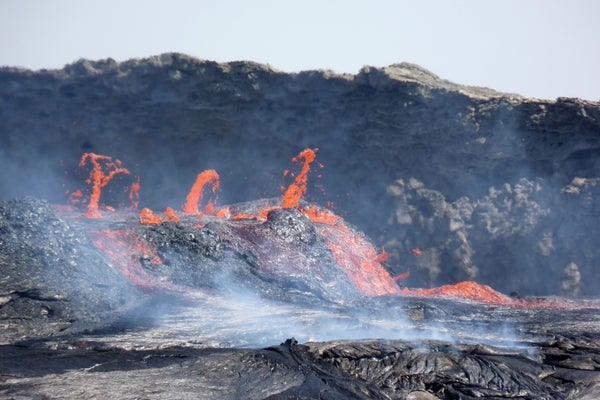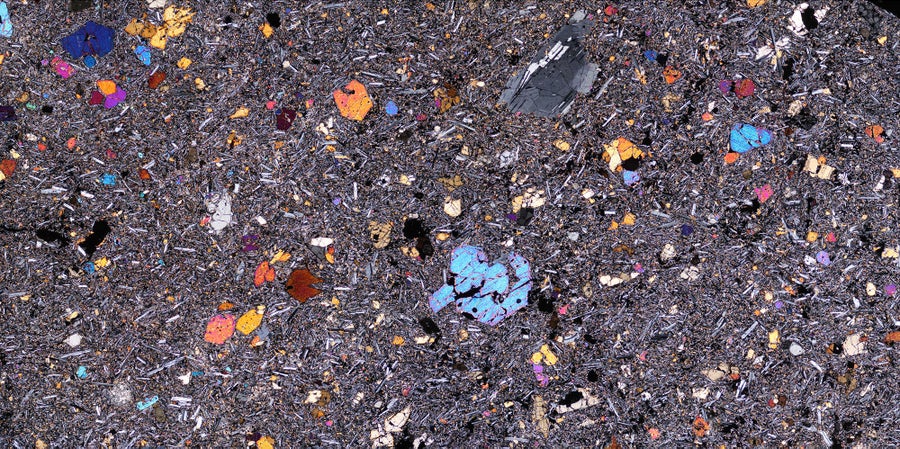Magma Pulses Are Tearing Africa Apart
Chemical fingerprints from volcanic rock offer hints of what’s happening in the mantle below the area where three rift zones meet in East Africa

Active lava flows spilling out of the Erta Ale volcano in Afar, Ethiopia.
Dr. Derek Keir, University of Southampton/University of Florence
A spot in eastern Africa called the Afar Triangle marks the meeting point of three rift zones—lines where Earth’s crust is being rent apart. Researchers haven’t been sure exactly what drives this rifting, but a new study in Nature Geoscience suggests it is caused by rhythmic pulses of molten rock from deep below the surface.
Scientists first proposed in the 1970s that a hot upsurge of material from Earth’s mantle, known as a plume, was occurring below this spot. Since then researchers have debated whether a single plume, multiple smaller “plumelets” or something else entirely is pushing the plates apart. Emma Watts, a geochemist at Swansea University in Wales, wanted to settle the question, so she and a team of geophysicists, geochemists and computational scientists put their heads together and came up with a likely answer.
“The more I look into it, the more I see that you’ve got to have all the pieces of the puzzle to see the big picture,” she says.
On supporting science journalism
If you’re enjoying this article, consider supporting our award-winning journalism by subscribing. By purchasing a subscription you are helping to ensure the future of impactful stories about the discoveries and ideas shaping our world today.
The team analyzed 130 rock samples from volcanoes in the Afar region. Chemical signatures from each sample helped the scientists piece together the movement of the molten rock below Earth’s surface: The researchers calculated the ratios of concentrations of elements such as lead and cerium, which can indicate whether deep mantle material has surged upward, as well as the ratios of different isotopes that each originated from slightly varying reservoirs within the mantle.

Microscope image of a thin sliver of one of the volcanic rocks from Afar, Ethiopia.
Dr. Emma Watts, University of Southampton/Swansea University
After comparing their data to computational models of various permutations of mantle plumes, the researchers have found that the best explanation for their observations is a single plume that moves upward in pulses. The pulses appear to exert varying pressure that pushes on each rift zone differently, depending on the way the rift moves and the thickness of the crust on either side. The Afar Triangle’s fast-spreading Red Sea Rift has pulses that move farther along the rift zone and that are more frequent than those of the slower-spreading Main Ethiopian Rift in the western part of the triangle.
“The rifting rates are really controlling what we’re seeing in the plume,” Watts says. “What we think is that [the Red Sea Rift is] spreading out faster…, so it has more space to move, and it’s being stretched out easier.”
The relationship between the mantle movement and the geochemical fingerprints is “exciting because it suggests geophysics and geochemistry can be married to infer large-scale geodynamic processes,” says Catherine Rychert, a geophysicist at the Woods Hole Oceanographic Institution, who was not involved in this research.
This is one of the first known examples of a dynamic mantle plume that responds to the tectonic plates above, so more research is needed to confirm the finding, Rychert says. Watts hopes this technique could be used in other rift systems and that more data from this system could give researchers a more precise view of what is happening deep below Earth’s surface.









